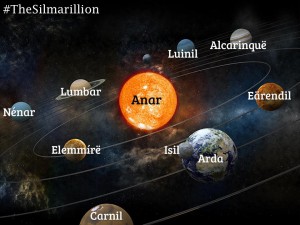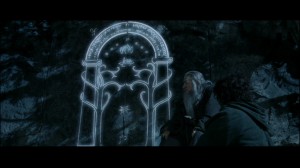
|
|
 |


|
|
|
|
|
|
|
|
|
|
|


News from Bree
spymaster@theonering.net
Oct 9 2013, 6:58am
Post #1 of 2
(414 views)
Shortcut
|
|
The astronomy of Middle-earth
|
Can't Post
|
|
[caption id="attachment_80273" align="alignright" width="300"] The Sun, the Moon and the Stars of Tolkien's universe - Eä. Note: As Larsen explains in the article, there is no evidence that Luinil or Nénar correspond to Neptune and Uranus. Sadly the artist got a bit over-enthusiastic. [/caption] The other day, we posted an essay by Ringer DarkJackal over at Heir of Durin exploring the confusion surrounding exactly when Durin's Day occurs. But even more widely, star lore -- and astronomy -- plays a significant role in the shaping of Middle-earth, both figuratively and literally. The Sun, the Moon and the Stars of Tolkien's universe - Eä. Note: As Larsen explains in the article, there is no evidence that Luinil or Nénar correspond to Neptune and Uranus. Sadly the artist got a bit over-enthusiastic. [/caption] The other day, we posted an essay by Ringer DarkJackal over at Heir of Durin exploring the confusion surrounding exactly when Durin's Day occurs. But even more widely, star lore -- and astronomy -- plays a significant role in the shaping of Middle-earth, both figuratively and literally.
In this fantastic essay, first presented at the RingCon Tolkien convention in November 2002, Dr. Kristine Larsen, Professor of Physics and Astronomy at Central Connecticut State University discusses the evolution of Tolkien's star lore, and its links with our own stars and constellations. It's a long read, but quite worthwhile.
The astronomy of Middle-earth
One question we might ask ourselves when embarking on a critical study of Tolkien’s work is "are we just reading too much into a story?" Christopher Tolkien argued for the authenticity of such analysis: "Such inquiries are in no way illegitimate in principle; they arise from an acceptance of the imagined world as an object of contemplation or study valid as many other objects of contemplation or study in the all too unimaginary world."
What we are doing is no less than the good professor did to himself. Tolkien wrote in a 1957 letter, "Naturally the stories come first. But it is, I suppose, some test of the consistency of a mythology as such if it is capable of some sort of rational or rationalized explanation."
Tolkien was ever mindful of the inner consistency of his universe, and that it was not utterly exempt from the rules of the mundane world in which we live. In fact, Tolkien stated emphatically that Middle-earth is envisioned as our world, in a time far before all recorded history: In a letter to Rhona Beare in 1958 he wrote, "I have, I suppose, constructed an imaginary time, but kept my feet on my own mother-earth for place."
In an earlier letter to his publishing company, he explained, "Middle-earth, by the way, is not a name of a never-never land without relation to the world we live in…. It is just a use of Middle-English middle-erde (or erthe), altered from Old English Middangeard: the name for the inhabited lands of Men ‘between the seas’. And though I have not attempted to relate the shape of the mountains and land-masses to what geologists may say or surmise about the nearer past, imaginatively this ‘history’ is supposed to take place in a period of the actual Old World of this planet."
[caption id="attachment_80276" align="alignright" width="300"] There are several competing theories as to which real-life constellation the Durin's Crown could be intended to mimic.[/caption] In shaping his vision of Middle-earth, Tolkien sometimes ran into "difficulties" of a scientific nature. One he frankly and openly admitted was in the area of biology: "Elves and Men are evidently in biological terms one race, or they could not breed and produce fertile offspring – even as a rare event: there are two cases only in my legends of such unions, and they are merged in the descendents of Eärendil." Given his mindfulness of natural laws, one may ask did Tolkien incorporate astronomical lore and fact into his universe? The answer is, in far more ways than can possibly be explored in a talk of this length. Astronomy helped, and haunted, Tolkien as he set out to develop his universe – or Eä, as the Elves would say. There are several competing theories as to which real-life constellation the Durin's Crown could be intended to mimic.[/caption] In shaping his vision of Middle-earth, Tolkien sometimes ran into "difficulties" of a scientific nature. One he frankly and openly admitted was in the area of biology: "Elves and Men are evidently in biological terms one race, or they could not breed and produce fertile offspring – even as a rare event: there are two cases only in my legends of such unions, and they are merged in the descendents of Eärendil." Given his mindfulness of natural laws, one may ask did Tolkien incorporate astronomical lore and fact into his universe? The answer is, in far more ways than can possibly be explored in a talk of this length. Astronomy helped, and haunted, Tolkien as he set out to develop his universe – or Eä, as the Elves would say.
One gets an immediate appreciation of just how deeply astronomical ideas are ingrained in the texture and fabric of Middle-earth from a study of the chronology of events in "The Lord of the Rings." Christopher Tolkien’s edited volumes of the "first drafts" of this classic tale (published as volumes in The History of Middle-earth) are bursting with references to the moon and its phases. It appears that much, if not all, of the internal chronology of Frodo’s journey across Middle-earth was timed by and to the phases of the moon.
[Read More]
|
|
|

RosieBaggins
Rivendell

Oct 9 2013, 2:57pm
Post #2 of 2
(368 views)
Shortcut
|
As for what Durians Crown was modeled after, I am leaning towards Cornea Boreas.

  
|
|
|
|
|














